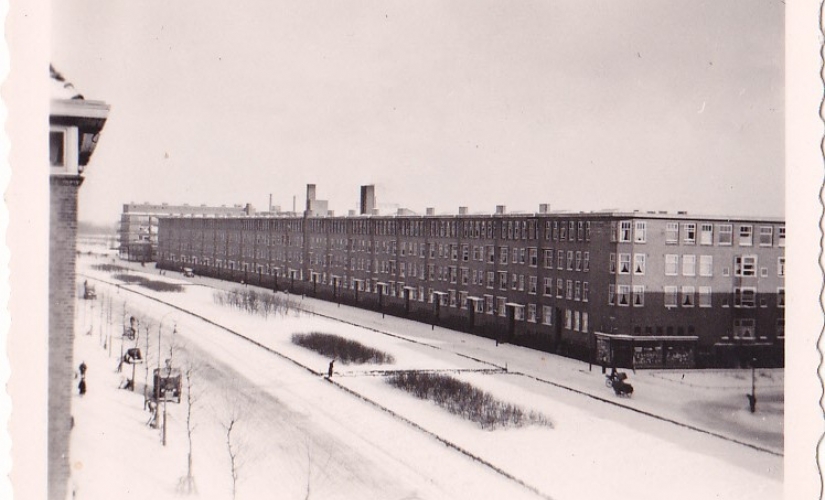
December 17, 2019
Growing up on the streets around the market halls
For our storytelling project, it's always wonderful when people take the initiative to write their own stories. Local resident Henk Ras did just that and submitted a story that we would like to share here. It begins at the Markthal but then transitions to his experience growing up on Willem de Zwijgerlaan in the 1950s.
“From the window on the third floor of our home on Willem de Zwijgerlaan, you could see the clock on the tower of the Markthal. You had to tilt your neck a bit because the tower was quite far away, but that’s how I always managed to be on time for school. We also had a clock on the mantelpiece, but we considered it less reliable than the clock of the Markthal. We’re talking about the 1940s, early ’50s. It was also during that time that I witnessed my first major fire. It also happened on the premises of the Markthal. There were three houses or sheds, somewhat secluded, mainly made of wood with thatched roofs. One day, they all caught fire simultaneously, and the fire brigade made no attempt to extinguish them. It was a magnificent sight.
During that same period, I discovered street football. With a group of boys and a ‘perrybal,’ all the conditions were met. Willem de Zwijgerlaan consisted of a wide road with cycle paths on both sides and an equally wide grassy area. There was also a narrower street that could be considered a service road, although it wasn’t exactly one. We played football on that section of the street, using lampposts, doorways, and drains as goals. Not all at once, of course, but we could choose from them.
A perrybal was actually a tennis ball that had worn out to the point where tennis players no longer wanted to use it. But we fought over it! Sometimes the ball unintentionally hit a window on the ground floor of one of the houses along the service road, but we quickly fled into a nearby doorway to avoid being seen by the residents. And after a few minutes, we resumed playing vigorously. Sometimes a police officer on a bicycle would appear at the beginning of the avenue, from Admiraal de Ruyterweg. He never rode fast, and we spotted him quickly, disappearing into the side street or, if one of the boys lived on the service road, through the cellar into the communal garden of the block.
Certainly, there were girls who played on the street. We played marbles with them or games like ‘stand in the wand’ or ‘diefie-met-verlos’ (a form of tag) and hide-and-seek. Spinning tops, skipping ropes, hopscotch were games that girls usually played among themselves. Boys were often not skilled at those.
What was remarkable was that each game seemed to be associated with a particular season. Spinning tops, if I remember correctly, were for early autumn. Skipping ropes were for the height of summer. But I don’t remember well, and I have never been able to figure out why those games came and went. It was just the way it was, and we accepted it.
As the evenings grew longer, after dinner, we would be back on the street, waiting for the vegetable carts. The greengrocers in the area would collect their vegetables, potatoes, and fruits from the Markthal early in the morning using hand carts, and those carts had to be returned empty in the evenings. Presumably to be loaded again with goods delivered to the Markthal from the countryside by barges through the Kostverlorenvaart. But it was quite a walk with those carts from the neighborhood to the Markthal. And halfway there, we, young boys, would be playing around. They asked if we could take those carts to the Market Halls. For a dime per cart. We didn’t mind at all. Moreover, around eight o’clock, the Jamin ice cream man would come by with his cart full of ice creams that cost exactly a dime. With chocolate, it was 15 cents, but we could often afford that too. In winter, of course, the ice cream man wouldn’t have ice cream but firewood, which you could use to light your stove. During the day, he would already come by shouting, “Firewood! Kindling!”
Recently, I took a walk through the neighborhood. It has changed, changed a lot. No shop remains the same, and the trees have grown into beautiful plane trees. The little river Krommert, where we used to attempt ice skating, has been filled in. The Haarlem tram disappeared more than half a century ago. And the Markthal is also swept away by the tide of time.
But the houses, many of them in the Amsterdam School architectural style, are often much more beautiful than I ever realized!”
Text by Henk Ras, 2019
Photo: View of the Markthal, 1946-1947 (presumably). Source: Historical Archive De Baarsjes/Simon van Blokland.